STANDARD OF THE BREED BASSETHOUND
WITH COMMENTS BY IVA ÈERNOHUBOVÁ

The breed standard is a written characteristics of the breed. The first breed standards apeared in Great Britain in early history of pure breeding. Its goal is to desribe general apearance of the hound, its typical breed marks, and contruction of body, head, legs and all details, that make a dog a true Basset Hound. The breed standard should be used by breeders to find and keep an ideal type of hound, and to use the ones, who seem to be as much close to the ideal as possible for further breeding. On dog shows the breed standard is used by judges to compare the exhibited dogs with breed standard. The modern Basset Hound origins from Great Britain, and that is why all countries, who are F.C.I. members, use the british standard. |
Comment: The standard is here realativelly short, but thurtfull. We should never forget, that Basset Hound is a hunting dog, so it should be able to run in the field. Allthrough it has a lot of substance, it should not loose its balance and elegance. It is very important for future and health of the breed, and especially breeders have to keep it in their mind. For me it is not a happy picture to see a fat Basset Hound, with too much loose skin, big belly and very short legs, that do not allow it to move free in the difficult terrain. Something like that is nothing more than exaggeration of breed characteritics and the dog looks more like a caricature. Such a exhibit should be loved as a pet, and not to winn any dog show it appears- and even to be used in breeding. |
Behaviour and temperament: Tenacious hound of ancient lineage which hunts by scent, possesses a pack instinct and a deep melodious voice. Placid, never aggressive or timid. Affectionate.
Comment: The temperament is also very important, because it is just its mild character, that is typical for the breed of Basset Hound. Distrustful, shyness or even agressivity are not acceptable, and should be allways penalized by the judge. A true Basset Hound is mild, placid and open to everyone. Extrems like apathetic or hectic and never ending barking are faults. |
Head: There may be a small amount of wrinkle at brow and beside eyes. In any event skin of head supple enough as to wrinkle slightly when drawn forward or when head is lowered.
Cranial region: Top of muzzle nearly parallel with line from stop to occiput and not much longer than head from stop to occiput.
Skull: Domed, with prominent occipital bone, of medium width at brow and tapering slightly to muzzle.
Stop: moderate
Facial region:
Nose: Entirely black except in light-coloured hounds, when it may be brown or liver. Large and well-opened nostrils, nose may protrude a little beyond lips.
Muzzle: General appearance of foreface lean, not snipy.
Lips: Flews of upper lip overlap lower substantially.
Comment: Head is a typical breed mark. All over the world there is a big difference in interpretation of the standard head, among breeders and also judges. Nevertheless there are several faults, that spoil the head and expression. |
Jaws / Teeth: Jaws strong, with a perfect, regular and complete scissor bite, i.e. the upper teeth closely overlapping the lower teeth and set square to the jaws.
Comment: An old rule says, that a hunting dog must have perfect and regular teeth. Teeth faults like undershot or one or two more teeth appear sometime in breed. It is a legacy of the past – an unregular forming of jaws are mentioned by early breeders in the beginning of breeding Bassets more than one hundred years ago in the old country of its origin – France. Still in the last century a level bite was accepted by the standard. Here less than a piece of milimeter means a fault, for which the dog can not be bred (depending on breeding conditions in the country). It can happen, that an adult Basset comes to a show - and it has a level bite, allthough in its young age it was judged to have scissor bite. It is because a level bite is developed with age. Nevertheless nowaday standard requiers scissor bite, and anything else should be penalised as a fault. |
Eyes: Lozenge-shaped, neither prominent nor deep-set, dark but may shade to mid-brown in light-coloured hounds. Expression calm and serious. Light or yellow eye highly undesirable.
Comment: Eyes give a typical look of the breed. The eyes should show its mild and calm temperament. Somewhat lighter colour destroys this typical characteristics. Unacceptable is so called blue or fish eye, that indicates a loss of pigmentation. |
Ears: Set-on low, just below line of eye. Long; reaching only slightly beyond end of muzzle of correct length, but not excessively so. Narrow throughout their length and curling well inwards; very supple, fine and velvety in texture.
Comment: Basset Hound together with Bloodhound have the longest ears between dog breeds. The long-legged Bloodhound desn´t have any problem with movement when it is about the length of ears. Too long ears on Basset Hound can cause a problem in moving. Especially a Basset Hound puppy in a certain period of its growing, stumble over its ears from time to time, when lowering its head to ground. It seems, that a puppy has to learn to walk with its long ears. The conclusion is, that the length of ears should be moderate, not exxagerated. The new standard defines the length of ears by changing the word „well“ to „only slightly. It is considered, that ears should be as long to reach slightly over the top of the nose, when drawn forward to dogs nose. So far to length of ears. Lets talk about the texture of ears. Flat “elephant” ear spoils the general view of the head. It is mostly caused by its sturcture, that is not enough fine and supple. |
Neck: Muscular, well arched and fairly long with pronounced but not exaggerated dewlap.
Comment: The neck is rather narrow when comparing to the width of shoulder – the longer the neck is, the more effect it makes. How long the neck should be? The length of neck should be in good relation to the body. Smooth arched neck, followed by straigth top line, ending in happily wagging tail of correct length – it is a perfect charakteristics of a beautifull Basset Hound. Long arched neck gives all over elegance and balance of the general appearance. Too short neck spoils it – such a hound seems to be cobby. One rule says, that a correct length of neck is checked, when a dog in move needs to low its head down to ground (for instance when following the scent): The neck is of correct length, just if it doesnt need to change the rythm and/or speed of its gait.
When it is about the dewlap, it of no doubt, that there have to be any. But – there is no mention to have the dewlap as much visible, that it beginns at the point of the muzzle, where the lips have to hang down and create the typicall silouette of a long muzzle of a Basset Hound. Too much dewlap changes the muzzle outline into strange shape.
|
Body: Long and deep throughout length; withers and quarters of approximately same height.
Back: Rather broad and level. From withers to onset of quarters not unduly long.
Loin: May arch slightly.
Chest: Forechest fitting neatly into crook when viewed from front. Breast bone prominent but chest neither narrow nor unduly deep. Ribs well rounded and sprung, without flange, extending well back
Underline and belly: There should be adequate clearance between the lowest part of the chest and the ground to allow the hound to move freely over all types of terrain.
Comment: The top line is straight and level, without tendency to lower. The level top line is very important for this breed, becuase of its body length. It is length of ribcage that makes strong top line, while loins is the only part of top line, that has no support from the body. That is why loins have to be short, and can be slightly arched. Weak top line is caused by not strong muscles or too long loins. If loins are too arched in movement, the reason can be steep hindquarters or steep pelvis. |
Tail: Well set-on, rather long, strong at base, tapering, with moderate amount of coarse hair underneath. When moving, stern carried well up and curving gently, sabre-fashion, never curling or gay.
Comment: The tail, whatever it is the last part of the hound, has big influence on final evaluating of the dog. Too curling or gay fashion spoils the general apearance. In no case the curving of tail should be in such a grade, that the tail touch dogs ridge. A judge should check by touching, if every vertebras are in right position - kinky tail is a deformation and serious fault. |
Limbs:
Forequarters:
General appearance Upper forearm inclined slightly inwards, but not to such an extent as to prevent free action or to result in legs touching each other when standing or in action. Some wrinkles of skin may appear on lower legs, but this must on no account be excessive.
Shoulder: Shoulder-blades well laid back; shoulders not heavy.
Ellbow: Turning neither in nor out but fitting neatly against side.
Forearm: Forelegs short, powerful and with great bone.
Carpus (wrist): Knuckling over highly undesirable.
Forefeet: Large well knuckled up and padded. Forefeet may point straight ahead or be turned slightly outwards but in every case hound always stands perfectly true, weight being borne equally by toes with pads together so that feet would leave an imprint of a large hound and no unpadded areas in contact with ground
|
Comment: The quality of the front prooves the quality of Basset Hound. The front supports the mayority of bodys weight, and that is why it must be a good supporter. |
|
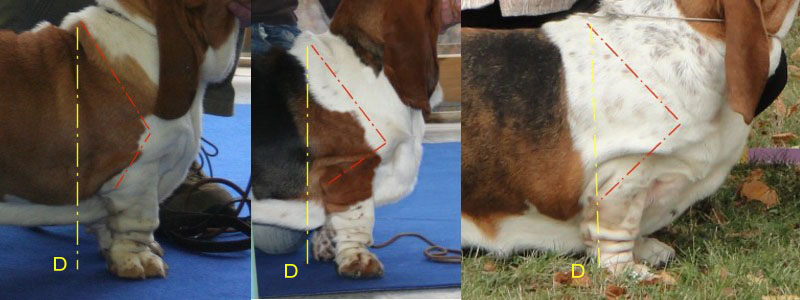
Yellow line down from withers shows the place, where the forelegs should be placed in ideal case (D). If forelegs are too much forward, it is because of short upper arm.
LEFT: Steep angulation as result of short upper arm and steep shoulder.
IN THE MIDDLE: Short upper arm. Look at the indication of forechest - in reality it is not more that a pouch of loose skin, that makes just an ilusion of forechest.
RIGHT: Correct example of front angulation with shoulder blade placed well back, creating upright angle with upper arm of correct length, that allow foreleg to stand just in the deepest part of chest (just under the withers).

Yellow line down from withers shows the place, where the forelegs should be placed in ideal case (D). If forelegs are too much forward, it is because of short upper arm.
LEFT: An example of short upper arm on a specimen with lot of loose skin, for which is necessary to measure the length of upper arm and placement of shoulder blade by touching.
SECOND FROM LEFT: A speciemn, who shows good forechest combined with rather short upper arm and loose ellbow.
FIRST AND SECOND FROM RIGHT: Another examples of short upper arms, which doesn´allow forelgs to stand just under the withers as well as under the deepest part of chest. These cases are in light degree, and is common in majority of Basset Hound population in Europe. Nevertheless it is good to know, that this is a fault.
Slightly curved upper arm just follows the curve of ribs to the elbow. Elbow is followed by the forearm. Curving of forearm goes down to the lowest part of ribcage, where is ended in joint of wrist. When viewed from the front wrist is placed correctly under the body, but not too close to each other to enable free movement without touching each other when standing or moving.
When viewed a sitting Basset Hound from the front, its front legs should be placed nicely under the deep chest, strong and upright to the ground, with paws straight or only slightly turning outwards. In case, when you can see evidently whole forearm and its curving down, or even the wrist placed somewhat in the front of the chest, then you can be sure that the front is not correctly built. Age of a dog plays in this item am important role: a youngster shows allways less chest, less of its depth, so that the front seems to be poor, while within few years the body develop and ribcage sets well into the „hole“. Nevertheless once the dogs shows steep shoulder, too short upper arm or loose elbow, it stays forever – and the only that happens in age is, that these faults can be „covered“ by fully developed body- loose skin, in better case muscles and in worse case- fat. Also joints of forelegs may strengthen in age.
Let´s talk about one of the hottest point of the breed during its development in last century– and it is a question of crooked legs – turning off the front feet. Some breeders consider crooked legs as a typical and original breed characteritics, another tried to breed somewhat straighter legs. Nowaday the standard requieres straight front or slight turn-off the front feet so that hound always stands perfectly true, weight being borne equally by all toes with pads, together so that feet would leave an imprint of a large hound and no unpadded areas in contact with ground.
Forefeet have to be strong, firm and full. The best comparison is to have feet like a cat – the only difference it the size of cause. They are firm, well knuckled up and padded, short toes. Sometimes we can meet flat feet of not enough bone. Another fault, much more heavy, is when weight is not equally borne to all toes, but just to some of them (looks like if the dog is waddling) – toes seem to be spread to sides. Another fault is not enough firm feet – toes are not close to each other. This appears sometimes on very massive feet, another time it has to do just with too long nails, which have to be cutted off.
Another front paw fault should be mentioned, and it is rubbing-off nails caused by uncorrect movement, if toes are dragged. You can recognise this gait from sound by scratching on hard ground. This way nails can be damaged to bleeding.
One more thing is important, and it is bone structure. A Basset Hound is heavy boned. If bone is too thiny, it makes a picture of a poor dog. Quality of food plays a very big role here. A dog of inherited quality can be spoiled by poor feeding, but on the other side good feeding can never improve poor gene pool.
How short should be the legs of a Basset Hound? It is a very important point, that is so much discussed, but yet there is no clear definition about this in the standard, when it talks about foreqaurters nor about the body. In this point the standard let us make our own conclusion, just states, that the hound must be able to do its traditional work and move on all kind of terrain. The american standard defines the maximum heigth of forelegs this clear way: the distance from the deepest point of chest must not exceed one third of height at withers. There is no mention of minimum heigth either – the american standard just require it must be adequate to allow free movement when working in the field.
During selection on short legs the breed of Basset Hound became very much short-legged. Breeders of show dogs seem to forget, that Basset Hound is a hunting dog, a hound, which has to be able to move freely for all kind of terrain. Too short legs is not a good equipment for this purpose. Now, when the new standard is valid, breeders have to think about this seriously and we will see in future, if any solution would be found. In no case we want to breed back on specimens, who are long-legged just because their ribcage is poor, they have not enough substance and long crooked legs. As far as we know, that short legs is result of gene changes, mutation, the whole matter seems not be easy. In fact it is about finding and breeding on such specimen, who have longer bones of forearm, in the part, where forearm leaves the ribcage and goes down to wrist – which makes the length of foreleg. Also the lenght and lean of pasterns influence the general heigth of foreleg. In general this is a very hard home-work, but it is the highest time to act seriously.

Examples of uncorrect wide fronts. In ideal case the upper arm should follow the curve of ribs to the lowest part of chest- if the upper arm is rather straight, then it result in wide front. LEFT in combination with loose ellbow, RIGHT in combination with too deep chest.

Another examples of uncorrect fronts:
LEFT: uncorrect narrow front with too turned-off feet.
IN THE MIDDLE: Too much turned-off feet (unpadded area in contact to ground).
RIGHT: The same fault combined with down in pasterns (nails do not touch the ground and pads are not fully on ground) small>

LEFT: Too much bone and loose skin. Loose ellbow hidden in loose skin. Loose skin fullfills the hole, where forechest should appear, and creates loose skin pouch on legs, what makes an ilusion of knuckling-over. If it is a reality or just ilusion, it is necessary to check by touching (see following picture).
THIRD FROM LEFT: Right front leg is knuckling-over. The chest could be deeper.
RIGHT: Short upper arm combined with loose ellbow, uncorrect front and too turned-off feet.

Too low to ground - fien examples - forlegs are too short.
LEFT: Correct front, feet and excellent forechest.
IN THE MIDDLE AND RIGHT: Short forelegs with too wide front in combination with too much loose skin ("skirt"). It is hard to imagine, that this specimen would be able to move feely on any kind of natural terrain.
Hindquarters:
General appearance: Full of muscle and standing out well, giving an almost spherical effect when viewed from rear. Some wrinkles of skin may appear between hock and foot, and at rear of joint a slight pouch of skin may be present, but on no account should any of these be excessive.
Stiffle (knee) Well bent
Metatarsus (rear pasterns): Hocks well let down and slightly bent under but turn neither in nor out and just under body when standing naturally.
Hind feet: Large well knuckled up and padded. In every case hound always stands perfectly true, weight being borne equally by toes with pads together so that feet would leave an imprint of a large hound and no unpadded areas in contact with ground
Comment: Hindquarters/rear is very important, because it gives movement to the long and heavy body of Basset Hound. Good muscles must be developed. When viewed from the rear, the amount of muscles gives allmost sferical effect. A commom fault is narrow hind. The hindquarters should never seem thiny comparing to forequarters. Sometimes this bad look is caused by steepness of rear: the thigh seems to be long and narrow. Correct angulation is on the picture. A stifle joint should be allways visible – well let down. Sometimes hock joint is too high and it results in rising top line. A combination of steep rear and too high hock joint seem to be mostly anatomical faults in rear. |
|
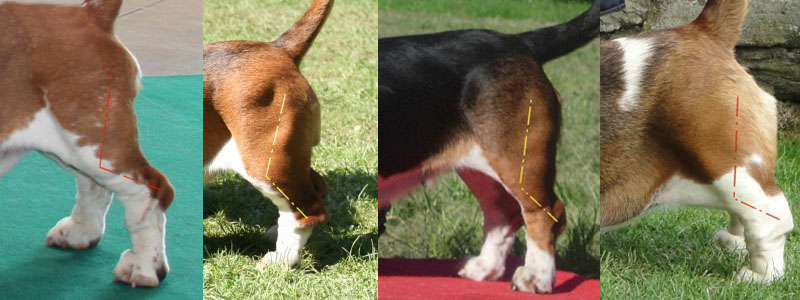
Uncorrect rear angulation
LEFT: Poor musculature. Too short lower tight and too high hocks. The stiffle angulation is allmost unvisible (steep stiffle).
SECOND FROM LEFT: Steep pelvis and rear angulation, which is much more worse in this moment, because the hind leg is not showed in ideal position - the handler should stand the hind leg much more behind the body, so that the angle of stiffle would be visible.
THIRD FORM LEFT: Steep rear angulation, poor long upper tight and too short lower tight.
RIGHT: Good bone, but short lower tight doesnt allow to find an ideal position for the feet, so that the angle of stiffle would be visible (steep stiffle).
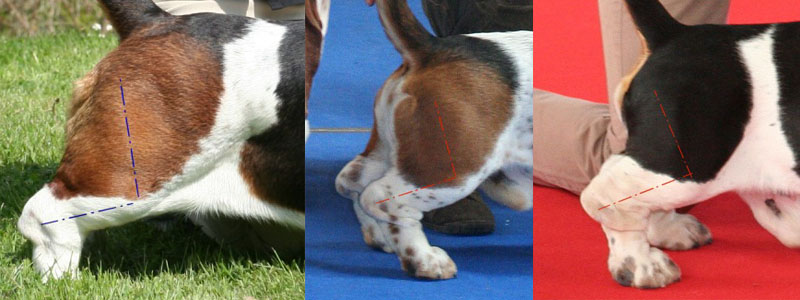
Three examples of good rear angulation, good bone and musculature.

Hindquarters from rear.
LEFT: So called "cow hocked".
SECOND FROM LEFT: Narrow rear (right leg is just on move).
RIGHT FIRST AND SECOND: Correct rear in move and stand.
Gait/movement: Most important to ensure that the hound is fit for purpose. Smooth, powerful and effortless action with forelegs reaching well forward and hind legs showing powerful thrust, hound moving true both front and rear. Hocks and stifles never stiff in movement, nor must any toes be dragged.
Comment: Movement is the best way of good evaluation of a hound - its good function of both fore- and hindquarters. Hound should be able to move effortless and to keep up with most other hounds in show ring and field as well. Movement shows, how every detail of anathomy works. It is also a question of good working condition of a dog. |
Skin: Supple and elastic without any exaggeration.
Comment: The definiton of skin is the brand new point in the F.C.I. standard, while the british original does´t have it. Being absolutely fenomenal for this breed, as well as for Bloodhound, loose skin is worthy to mention. There is no other hound breed, who would have so much loose skin as Basset Hound and Bloodhound. The former standard talked about „loose“ skin, now we talk about supple and elastic skin, what seems to be much more deliberate. |
Coat: Hair: Smooth, short and close without being too fine. Whole outline clean and free from feathering. Long hair, soft coat or feathering highly undesirable.
Comment: There are some differences in structure of the Basset Hound coat. While some Basset Hounds have very hard coat, especially on its back, others have very velvet structure and short hair. The top coat is long 1 to 4 cm on back, and hardly half cm on head. Some differences are also in developing of winter coat. The undercoat is very dense on dogs, that are kept outdoors. In every case a shining smooth coat appears on healthy dog. It is especially visible on dark tricoloured specimens. |
Colour: Generally black, white and tan (tri-colour); lemon and white (bi-colour); but any recognized hound colour acceptable.
Comment: The two most common colours in Basset Hound varies in brown saturation from lemon over red to liver. The colour may blend together. Placing and size of patches doesnt have any importance. But it is clear, that colouring has certain influence on general picture of a dog. For instance brown mantled colouring gives a nice picture of top line and shape of ribs. White blaze makes beautiful expression to the face. But white colour on legs up to hocks make an ilusion of long hocks, what can destroy a balanced all-over picture. Different coloured patches on the top of the ridge (dark patch in white, white patch in black or brown mantle) can spoil for instance level course of top line, while white line on neck can make the neck longer. Dark shading in face, especially around eyes has also influence on general impression. Rarely a curious colouring appears between puppies in the litter, for instance white coloured ear. It is considered as no fault. |
Size: Height at the withers: 33 - 38 cms.
Comment: The relatively big interval between lowest and highest limit is so open, that allmost every pure bred Basset Hound fits in. It is in no case one or two centimeter, that decide about quality of a Basset Hound. However european Basset Hound are in general bigger than their colleagues from North America. The reason can be in american standard, that has a maximum limit 15 inches (38,2 cm) and height over this limit is disqualification. |
Faults: Any departure from the foregoing points should be considered a fault and the seriousness with which the fault should be regarded should be in exact proportion to its degree and its effect upon the health and welfare of the dog and on its ability to perform its traditional work.
Comment: The F.C.I. Basset Hound standard has no special list of serious faults - with exception of generally stated item concerning physical or behavioural abnormalities on dogs. By this way, especially the all-rounder judges have no guidelines, so only their own sense for the breed (and in many cases just only sense for beauty) help them to evaluate the breed properly. Breed specialist, whose knowledge is based on own experience in breeding, is able to find, define and comment certain faults, that should be pursued by breeders to elimininate them in further breeding to keep Basset Hound fit and healthy. |
Disqualifying faults:
• Aggressive or overly shy
• Any dog clearly showing physical or behavioural abnormalities shall be disqualified.
N.B.: Male animals should have two apparently normal testicles fully descended into the scrotum.
Comment: The new standard contains a special point with definintions of disqualifying faults. It is in no case as long as in many other breeds, but it is focused just on faults in behavior and physical abnormalities. |
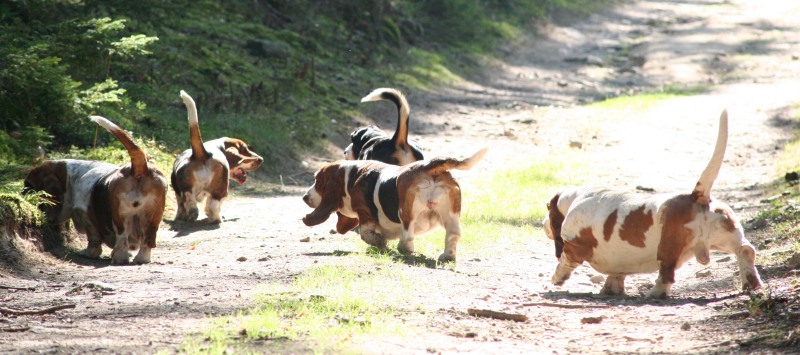
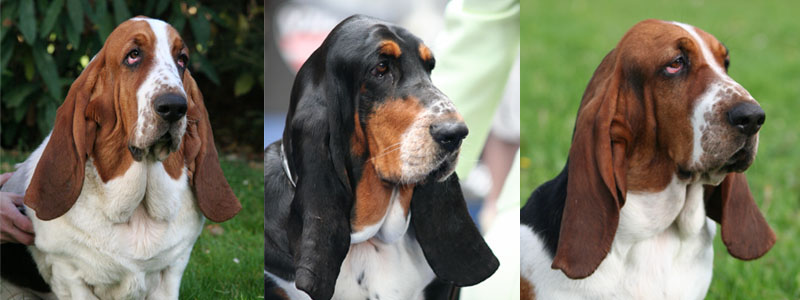
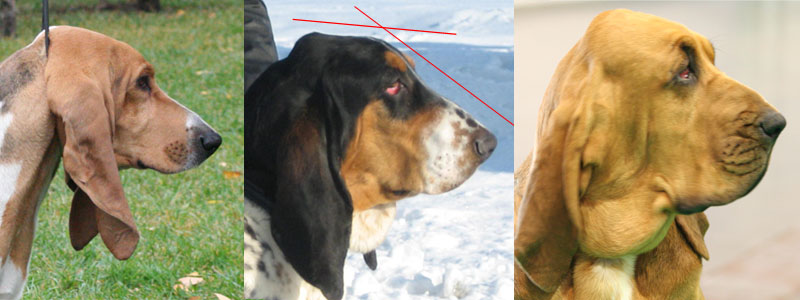


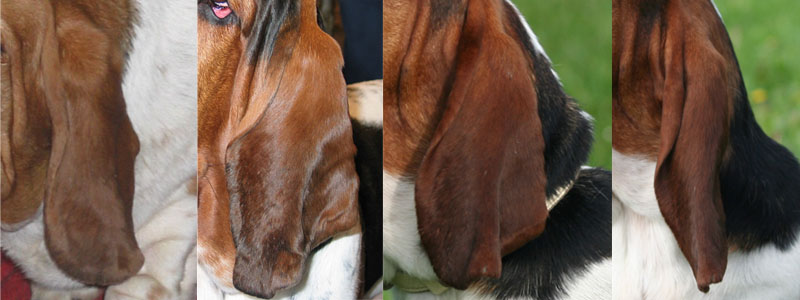





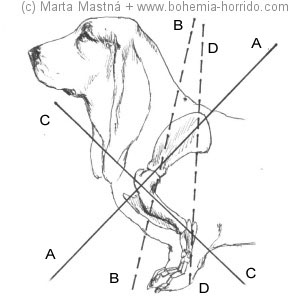
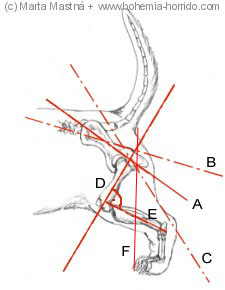 Rear angulation :
Rear angulation :
